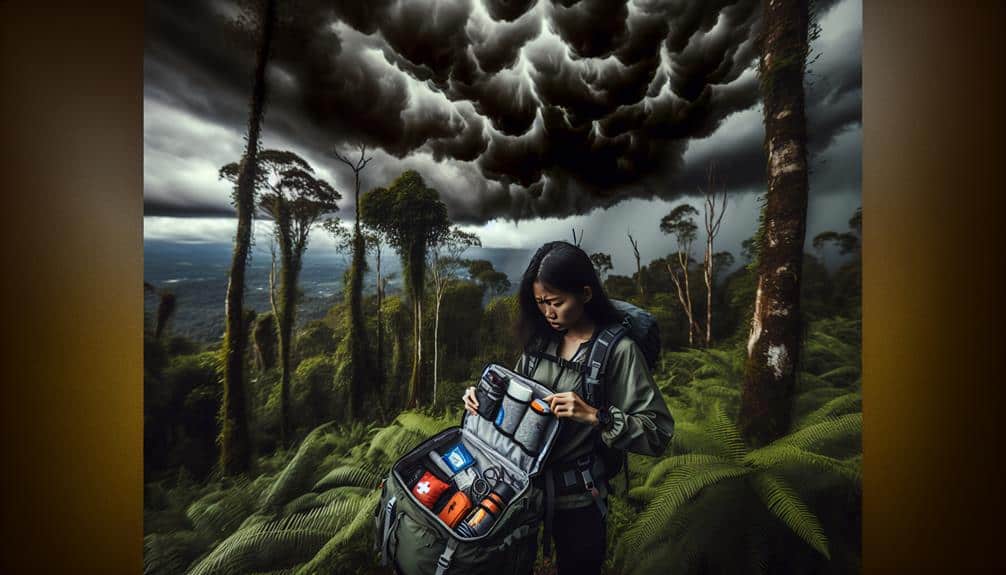When we venture into the wild, seeking remote storm shelters can often be life-saving against nature's unpredictable and dangerous weather. By identifying natural shelters like caves or building makeshift ones with branches and tarps, we shield ourselves from storms, harsh winds, and potential hazards. We must prioritize safety by avoiding low-lying areas where water pools and ensuring our chosen shelter is visible to rescue teams. With essential gear like thermal blankets, multi-tools, and reliable communication devices, we can be well-prepared and enhance our chances of staying safe. This essential knowledge can make our hiking adventures much more secure.
Key Points
- Provides immediate protection from life-threatening weather conditions during a hike.
- Natural and makeshift shelters can shield from severe elements and reduce exposure.
- Choosing safe shelter locations helps avoid hazards like flooding and strong winds.
- Properly planned shelters increase visibility for rescue teams in emergencies.
Importance of Storm Safety
Storm safety is essential because it protects us from potentially life-threatening weather conditions while hiking. When we're out in the wilderness, far from immediate help, our best defense against severe weather lies in proper weather preparedness and emergency planning.
As outdoor enthusiasts, we're aware that nature's unpredictability can turn a peaceful hike into a dangerous situation. To safeguard our safety, we must prioritize checking weather forecasts before setting out. Understanding the potential for storms and severe weather helps us make informed decisions about our journey.
Additionally, packing essential gear, such as waterproof clothing, first aid kits, and reliable communication devices, is non-negotiable. These preparations give us the flexibility to adapt to sudden changes in weather while staying safe.
Moreover, having a solid emergency plan is critical. We should always inform someone of our hiking route and expected return time. Knowing the locations of nearby shelters or natural cover can make a significant difference in an emergency.
Practicing how to respond to various weather scenarios, like lightning storms or flash floods, equips us with the knowledge to act swiftly and effectively. By committing to these measures, we can embrace the freedom of the outdoors with confidence and security.
Types of Remote Shelters
Knowing how to find and utilize different types of remote shelters can be a lifesaver when unexpected storms catch us off guard during a hike. Natural shelters like caves or overhangs provide immediate protection, but we should always inspect them for safety hazards like loose rocks or wildlife.
Another option is building a makeshift shelter using available materials. Fallen branches, leaves, and even our own gear can serve as essential shelter materials. Tarps and ponchos are versatile tools that can be quickly adapted to create a waterproof barrier.
When natural options are scarce, we can employ emergency protocols to construct effective shelters. The lean-to is a classic example, requiring us to prop a sturdy branch against a tree and cover it with smaller branches and foliage. This design shields us from wind and rain efficiently. In snowy conditions, a snow cave or trench can insulate us from the elements, using snow's inherent insulating properties.
We should always carry some basic shelter materials, like a compact tarp, rope, and a multitool, as part of our emergency protocols. These items can make all the difference when nature surprises us. Preparedness in selecting and utilizing these shelters guarantees our safety and peace of mind on the trail.
Ideal Locations for Shelters
Selecting the right location for a shelter can greatly enhance our safety and comfort when hiking. Proper shelter placement isn't just about finding a spot to rest; it's an essential part of our emergency preparation. Let's make sure we're making the best choices to handle unexpected storms and other emergencies.
When choosing an ideal shelter location, consider these key factors:
- Elevation: We should avoid valleys and low-lying areas where water can pool during a storm. Instead, aim for slightly elevated spots that provide good drainage.
- Natural Barriers: Look for natural windbreaks like large rocks, dense vegetation, or terrain features that can shield us from harsh winds and flying debris.
- Visibility: In an emergency, being easily visible from a distance can be lifesaving. Opt for locations that aren't concealed from view, ensuring rescue teams can locate us quickly if needed.
- Proximity to Resources: Make sure our shelter is close to essential resources such as water sources and firewood, but not too close to potential hazards like falling branches or rockslides.
Accessing Remote Shelters
Finding your way to remote shelters demands a strong understanding of the terrain and dependable navigation tools. We can't downplay the significance of a well-prepared approach when nature's fury is upon us. When natural disasters like storms or flash floods strike, having a pre-planned route to a remote shelter can make all the difference.
First, let's talk maps and GPS devices. Topographic maps give us an aerial view of the landscape, helping us identify potential shelters. Coupled with a GPS device, we can pinpoint our location and chart a safe path. In areas where GPS signals might falter, a compass and map skills are essential.
We also need to take into account the terrain's challenges. Steep inclines, dense forests, and water bodies can slow us down, highlighting the need for physical preparation and proper gear. Understanding these obstacles ensures our emergency response is quick and efficient.
Communication is crucial. A reliable satellite phone or emergency beacon can alert rescuers to our location if we're unable to reach the shelter. Remember, natural disasters are unpredictable.
Shelter Essentials to Carry

Preparation is key, and carrying the right shelter essentials can greatly enhance our safety and comfort during unexpected storms. When we're out on the trail, having the right survival gear and emergency supplies can make all the difference.
Here's a list of essential items we should always carry:
- Portable Shelter: A lightweight, durable tent or bivy sack can protect us from the elements. It's our first line of defense against rain, wind, and cold.
- Thermal Blanket: Compact and effective, thermal blankets retain body heat and are an essential part of our emergency supplies. They can prevent hypothermia when temperatures drop unexpectedly.
- Multi-Tool: This versatile piece of survival gear can come in handy for various tasks, from cutting rope to repairing gear. It's a small item with significant utility.
- First Aid Kit: Accidents can happen anywhere. A well-stocked first aid kit allows us to quickly address injuries and continue our hike safely.
Frequently Asked Questions
How Can I Find Accurate Weather Forecasts for Hiking Areas?
We can guarantee emergency preparedness and reliable weather monitoring by using apps like AccuWeather, checking local meteorological websites, and tuning into NOAA radio. Staying informed keeps us safe and lets us embrace our hiking adventures with confidence.
What Are the Signs of an Approaching Storm While Hiking?
While hiking, we should watch for warning signs like darkening clouds, sudden temperature drops, and increasing wind speed. Storm preparation includes having a plan and knowing these signs to stay safe and maintain our freedom on the trail.
Can Animals Seek Shelter in the Same Places as Humans?
Yes, animals can seek shelter in the same places as humans. Understanding animal behavior helps us choose shelter options. We must stay alert to coexist safely, ensuring both we and the wildlife find refuge from the storm.
How Do You Stay Calm During a Storm in the Wilderness?
Did you know that 75% of people report calming effects from deep breathing techniques? We stay calm during storms by using visualization, mindfulness practices, and grounding exercises. These methods keep us centered and focused on the present moment.
What Should I Do if I Get Lost While Seeking a Storm Shelter?
If we get lost seeking a storm shelter, we should stay put, use our survival tips, signal for help, and contact emergency contacts if possible. Staying calm and conserving energy increases our chances of rescue and safety.


